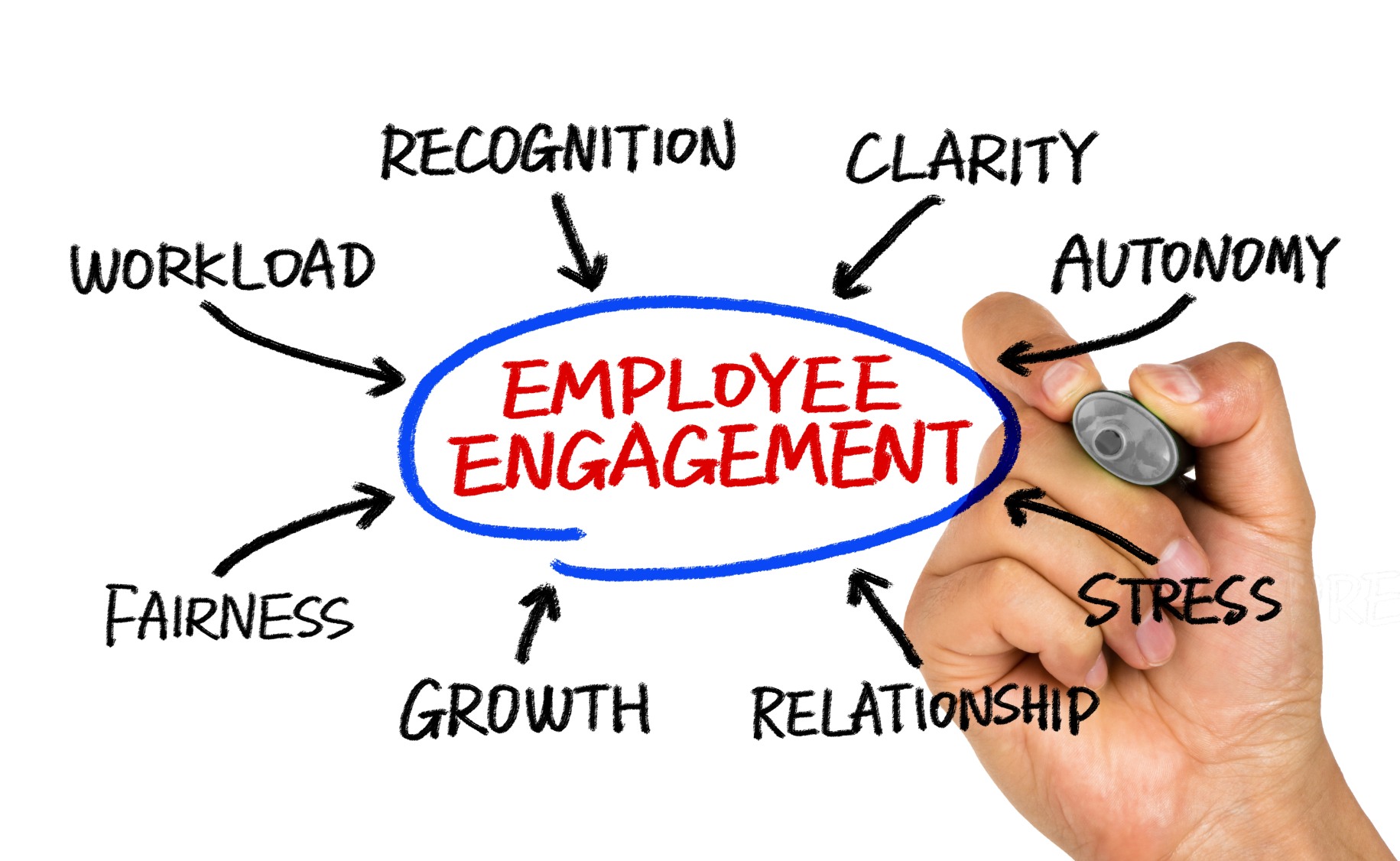It’s critical that employees feel engaged at work, or their excitement and thirst for improvement in their role will quickly dwindle. This blog is a must-read if you want your employees to enjoy their time at work and feel like their contributions matter. In this blog, we discuss what engagement in the workplace is, what it looks like, how to achieve it, and how to fill the gaps, if there are any.
What is Employee Engagement?
Before March 2020, business owners wanted to maximize their space and minimize their costs. Stretching the dollar was the primary focus. While that is still a priority, there is a newer and more pressing priority: giving employees the best possible work environment—and designing workplaces that allow that to happen. Moving forward, the goal is to maximize how spaces are used and to ensure they are flexible enough to support various work styles and workstations.
Productivity increases 20-25%[2] when employees are engaged. Employee engagement includes many factors—some of which are discussed in this blog—but when you boil it down, it is about improving the work environment and culture to encourage employees to be more committed to company goals and values. A business with strong employee engagement benefits everyone: business owners and stakeholders, management, and staff. Engaged employees are more motivated and productive and are more willing to go above and beyond the call of duty.

Uncover Your Employee Engagement Pain Points
Before you can assess employee engagement or create plans to strengthen it, you first need to uncover the pain points. Don’t be afraid to shine a light on the engagement pain points your organization is dealing with because you can’t move forward until you take this crucial step. It is necessary to acknowledge and recognize the weaknesses because only by doing so will it be possible to formulate the strategies to implement changes that will improve employee engagement.
Typical Engagement Pain Points
- Lack of leadership: When leadership is lacking, it can result in high turnover or employees who are not motivated to do well or advance in their roles, impacting the bottom line.
- Little reward or recognition: If employees do not feel valued, the result is often a loss of interest in buy-in regarding department or company initiatives.
- Insufficient professional growth opportunities: When we cannot grow, we become bored. If employees are not provided professional growth or promotion opportunities, they may become apathetic about their job (or look for a new one).
If your organization has poor engagement, consider addressing the above pain points. Also, note that workplace culture and team cohesion are critical for team productivity, individual performance, and employee motivation. A good workplace culture increases engagement, retention, and overall well-being while minimizing fear, stress, anxiety, and burnout.

How to Strengthen Employee Engagement
- Have a strong onboarding strategy: When people are given proper training at the onset of their role with an organization, they will be more engaged in their job and overall role.
- Provide ongoing training: Provide professional growth opportunities. Give people proper training throughout their time with the company because 51% of people would quit their job if training was not offered.[3]
- Encourage collaboration: When employees are encouraged to collaborate, they build on each other’s thoughts and ideas. As a result, the collective process enhances the final output.
- Recognize accomplishments: This includes recognizing the contributions made by both individuals and teams. This helps employees feel a sense of value in their work, strengthening their commitment to the company. (Better yet, ask them what makes them feel valued and how they like to receive recognition.)
- Have an inclusive communication strategy: Ensure that your staff has a voice and that you listen to them. Remind them that their opinions matter and that feedback is welcome and wanted. All management staff should do this consistently, or pools of discontentment will flourish. We recommend using feedback tools like Slido for all-staff meetings.
- Provide flexibility in the workplace: Flexibility includes where they can work from, what their work hours are, and when those hours can be completed. When you give someone autonomy in how they allocate their time, effectiveness increases.
- Performance conversations: Terminology matters. We recommend calling them conversations, not reviews, because reviews can be intimidating and scary while conversations are not. Try to schedule these conversations every six months, and remember, your staff should not be surprised by anything discussed during these conversations. Feedback should be provided as issues come up.
- Reward managers for engaged employees: Behaviour follows rewards. Traditional compensation management systems have been focused on productivity and profit. Engagement is now a critical element if you want to change your culture.

Colleagues are More Important Than You Might Think
During a webinar in April 2022 about workplace engagement, Allsteel asked participants to vote on what made them feel energized at work, and the results were surprising but also telling:
- Colleagues (45%)
- Natural light (12%)
- Productivity/getting work done (38%)
- Food and drink (3%)
- Workstation (2%)
The webinar speakers wondered if colleagues ranked so high because, post-pandemic, people now realize how important who you work with is. Socialization is an essential need, so Allsteel recommends that business owners design spaces for activity and collaboration—if your space allows. What happens in a workplace is dynamic, fluid, and constantly shifting. The space needs to be flexible enough for these changes.

Use Employee Engagement to Retain Staff
Having staff feel engaged at work is a critical component of retainment. Employees have a lot of power these days, which is good. Because that makes it easy to ensure they are happy, which likely means they are engaged. As business owners, we need to ensure that everything about our place of work is of the highest standard and quality, or we risk losing some of our best employees. If engagement is low, turnover is high.
Research indicates that workers have three fundamental needs: interesting work, recognition for doing a good job, and being let in on things that are going on in the company. When you have engaged employees, they are less likely to resign, which is ultimately the goal of any organization.
You want to retain staff for as long as possible because hiring and training is a considerable investment that requires time and money. When you lose a great staff member, you lose all the company knowledge that person had. A turnover rate says more about a company than it does an employee. (Plus, highly engaged workplaces see 41%[1] lower absenteeism.)

Measure Engagement
If you want to have positive employee engagement in your organization, measure it. This holds everyone accountable, and it identifies ways that you can further improve your workplace. Ways to measure engagement include short, frequent surveys, meeting with individuals, doing exit interviews with staff who are leaving, and analyzing employee turnover and absenteeism rates.
Here at Truspace, we send a monthly survey to all staff members with four questions that assess the following topics: relationships, company motivators, personal motivators, and happiness. This survey lets us know how our employees feel, which gives us a baseline for moving forward. This type of survey aims to reveal what makes your employees energized and what they need to do to feel motivated about their daily activities. Share the results with your staff as this helps build purpose, increasing engagement.

Everyone Benefits from Employee Engagement
Employee engagement is a win-win strategy for both the employer and the employee. When engagement is a top priority, the employee feels valued, connected, and represents the company in an overwhelmingly positive manner. The employer benefits from an engaged staff group that contributes, feels good about the organization, and will put in their best effort and stay with the organization, in many cases, even if they are offered a better job.
Employee engagement starts at work, but it also stretches outward into your employees’ personal lives, impacting how they feel in their day-to-day lives and how they talk to others about their job and the company they work for. If you want to minimize absenteeism and turnover but increase employee motivation, productivity, and overall well-being, focus on creating a highly engaged workforce.
Study after study shows that it is an often overlooked but much-needed aspect of any organization that wants to have its employees feel excited and that they are an integral component of company growth. Employees who feel engaged in their job and the company they work for will naturally become brand advocates, improve customer service, and increase sales for the company. Who knows, engagement could be your new recruitment strategy!
To learn more on this topic, see the following reference materials we used in creating this article:
1. Why is Employee Engagement Important?: https://everyonesocial.com/employee-engagement/
2. The social economy: Unlocking value and productivity through social technologies: https://www.mckinsey.com/industries/technology-media-and-telecommunications/our-insights/the-social-economy
3. 2018 Skills Gap Report: https://research.udemy.com/research_report/2018-skill-gap-report/


.jpg)
.jpg)
.jpg)